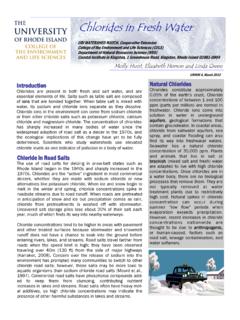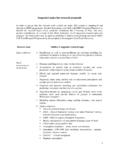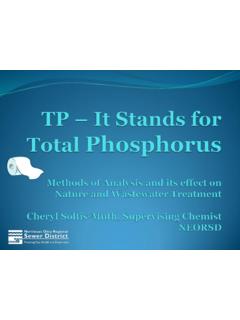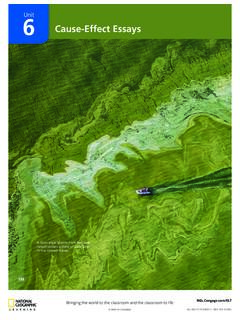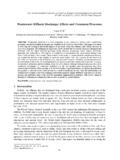Transcription of Dissolved Oxygen and Temperature - University of Rhode Island
1 Lakes and ponds. In sunlight, aquatic plants and algaeproduce Oxygen within aquatic ecosystems through pho-tosynthesis. Turbulence and currents circulate DOthroughout Oxygen Fluctuates DailyThe DO concentration within a waterbody canexperience large daily fluctuations. Aquatic plants andalgae produce Oxygen as a by-product of photosynthesisby day. But at night, they consume Oxygen through res-piration. Productive lakes, lakes with large populationsof aquatic plants or algae, are likely to experience thegreatest DO fluctuations. In such lakes, the DO con-centration is usually lowest just before sunrise, and high-est in late afternoon (Caduto 1990). In some highly pro-ductive waterbodies, DO is consumed by night-time res-pirationfaster thanit is re-placed byoxygendiffusingfrom ,fish andother lakeorganisms may die from lack of Oxygen (Simpson 1991).
2 What Affects Dissolved Oxygen Levels?The amount of Oxygen Dissolved in a waterbodyis affected by salinity, altitude, groundwater inflow, andwater Temperature . Salinity is how much salt is in thewater. Although it is generally not a concern in mostfreshwater lakes, salinity can greatly affect Oxygen solu-bility in estuaries, brackish waters, bogs, and waterbodiesNatural Resources FactsUniversity of Rhode Island College of Resource DevelopmentDepartment of Natural Resources Science Cooperative ExtensionMarch, 1997 Fact Sheet Oxygen and TemperatureKelly Addy is a Graduate Research Assistant in the Department of Natural Resources Science, University of Rhode Island . Linda Green is Program Directorof University of Rhode Island Watershed Watch and a Research Associate IV in the Department of Natural Resources Science, University of Rhode #3459 of the College of Resource Development, University of Rhode Island , with support from Rhode Island Cooperative Extention and partialsupport from the Gloria Hurley Watershed Watch endowment of the URI Oxygen and Temperature are two ofthe fundamental variables in lake and pond ecology.
3 Bymeasuring Dissolved Oxygen and Temperature , scientistscan gauge the overall condition of waterbodies. Aquaticorganisms need Dissolved Oxygen for their survival. Whilewater Temperature also directly influences aquatic organ-isms, it regulates Dissolved Oxygen concentrations withina lake. Dissolved Oxygen and Temperature are also usedto classify lakes. This fact sheet describes why lakes needdissolved Oxygen , characterizes daily and seasonal dis-solved Oxygen concentrations, discusses how tempera-ture affects lakes and Dissolved Oxygen concentrations,explains methods of classifying lakes using Dissolved oxy-gen and Temperature , and specifies how Dissolved oxy-gen and Temperature are Do Lakes Need Oxygen ?
4 Dissolved Oxygen (DO) is the amount of oxy-gen in solution. Without Oxygen , lakes could not sup-port life. All organisms in a lake, from fish to insects tomicroscopic zooplankton, need Oxygen for respiration, organisms consume Oxygen and giveoff carbon dioxide while absorbing food molecules toobtain energy for growth and maintenance (Caduto 1990).Since different organisms survive at different op-timal Oxygen levels, the amount of DO determines whichorganisms a lake can support. High Oxygen contents areneeded by some species, such as trout. Other species,including carp, catfish, water fleas, and zooplankton, haveadapted to survive under low Oxygen conditions. Someorganisms can even live in environments where oxygenlevels fluctuate significantly.
5 Even plants respire at nightwhen lack of sunlight prevents photosynthesis. Decom-position of dead plant and animal material also requiresDO. In addition, DO concentration controls importantchemical reactions in bottom sediments of is introduced into lakes in a variety ofways. Wind and wave action bring Oxygen intowaterbodies. Inflowing streams can also carry DO intoKelly Addy and Linda GreenWater Temperature can vary within a lake, tre-mendously influencing lake ecology. Thermal stratifi-cation, or Temperature layering, generally occurs in lakesand ponds greater than 5 meters ( feet) in occurs because water at different tempera-tures has different densities. The typical annual cycle ofthermal stratification has several phases (Caduto 1990,Kortmann and Henry 1990, Simpson 1991).
6 The firstphase, spring overturn, occurs in early spring when ris-ing air temperatures warm surface water and melt icecover. The entire water column stabilizes to a uniformtemperature as wind action mixes the water from top air temperatures increase in spring and sum-mer, lake water also warms up. Surface water warmsmore rapidly than deeper water. Because the warmer,surface water is lighter than the colder, deeper water,these lakes separate into three distinct thermal layers ( ). The surface layer, the epilimnion, is warmed bysunlight and mixed by wind action. The middle layer,the metalimnion, is a transition zone. The bottom layer,the hypolimnion, receives minimal sunlight and doesnot mix with the upper layers.
7 As summer progresses,the depth of the epilimnion increases as the warm tem-perature water penetrates deeper into autumn, lower air temperatures cool thesurface water. When the surface water (epilimnion) coolsto the same Temperature as the hypolimnion, stratifica-tion is broken, and all the water in the lake circulatesfreely in response to wind action. This process, similarto spring overturn, is called fall winter as air temperatures grow colder, lakesmay stratify again. As opposed to summer stratifica-tion, during winter stratification, the upper zone is colderthan the bottom waters. An ice layer may form on thesurface of the lake preventing sunlight and Oxygen fromentering the agricultural areas (Campbell and Wildberger 1992).
8 Higher salinity reduces the amount of Oxygen that candissolve in the water. Due to lower atmospheric pres-sure, lakes in higher altitudes usually have lower levelsof DO. Groundwater, which does not have contact withthe atmosphere, typically has lower levels of DO thansurface waters. When groundwater enters a lake, DOconcentrations are initially reduced near the spring (Caduto1990). However, groundwater is generally colder thansurface waters (Caduto 1990). Colder water holds moreoxygen than warmer water. By reducing lake water tem-perature, groundwater inputs increase the ability of awaterbody to hold Oxygen in the long term. Of thesevariables, Temperature most directly effects DO in lakesand Does Temperature Affect Lakes?
9 Many factors influence lake and pond water tem-perature, including seasonal air Temperature , water depth,groundwater inflow, stream flow, mixing due to windand water currents, and the amount of sunlight and Temperature plays an important role in aquatic eco-systems. It limits the migration, spawning, egg incuba-tion, growth, and metabolism of aquatic organisms. Aswith DO, each aquatic organism has an optimal tempera-ture range for its metabolism. Warmer water promoteshigher metabolism and respiration Temperature also affects lakes indirectlyby influencing DO concentrations. Warm water holdsless Oxygen in solution than cold water. Percent satura-tion can be used to describe the DO status of a lake.
10 Per-cent saturation is calculated as:DO concentration measured in the lakemaximum DO concentration at that temperatureThe bottom half of this equation indicates the impor-tance of Temperature in relation to DO capacity of 1:In summer, deep lakes mayundergo thermal stratification. Astratified lake is separated intothree thermal layers: the epilim-nion (warm surface layer), themetalimnion (transition zone),and the hypolimnion (coolbottom layer).Adapted from The Lake andReservoir Restoration GuidanceManual, EPA 440/5-88-002 Thermal stratification causes extreme DO con-ditions within a waterbody. Since there is no replenish-ment of Oxygen to the bottom waters, Oxygen in thesebottom waters may gradually become depleted by decom-posers that live in, or on bottom sediments.
